Your nose warms and filters the air you breathe. It also gives you your sense of smell. When you’re sick, you might have nasal symptoms like congestion or a runny nose. Regular nasal hygiene can keep you healthy and improve your overall well-being.
Advertisement
Cleveland Clinic is a non-profit academic medical center. Advertising on our site helps support our mission. We do not endorse non-Cleveland Clinic products or services. Policy

Your nose, a structure that sticks out from the middle of your face, is the entrance to your respiratory system. It warms, conditions and filters the air you breathe. It also houses your olfactory organs, which give you your sense of smell.
Advertisement
Cleveland Clinic is a non-profit academic medical center. Advertising on our site helps support our mission. We do not endorse non-Cleveland Clinic products or services. Policy
Words that start with “naso-” (like nasopharyngeal) or “rhino-” (like rhinoplasty) usually refer to your nose. And if you develop a health condition that affects your nose, you’ll likely visit an otolaryngologist (ENT).
The human nose has many important jobs related to breathing and your sense of smell.
Your nose:
The outside parts of your nose (the parts you can see) consist of bone, cartilage and fatty tissue. They include your:
The inside of your nose has several complex structures, too, including:
Advertisement
Noses are somewhat pyramid-shaped, and they come in all sizes. Your nasal bone and cartilage play a major role in your nose shape, which is as unique as you are.
Nasal congestion is the most common condition affecting your nose. This happens when allergens or pathogens (viruses, bacteria, or fungi) cause inflammation of your nasal passages.
Other health conditions that can affect your nose include:
Depending on what type of nasal condition you have, you might experience symptoms like:
Nasal endoscopy is one of the most common nose procedures. It helps healthcare providers diagnose and treat a wide range of nasal conditions like infections, blockages and polyps.
Other common nose-related treatments include:
Nasal hygiene is an important aspect of health. Below are some tips to keep your nose and nasal passages in good condition:
You should tell your healthcare provider if you have:
You use your nose every minute of every day. Still, you might not think about it much unless it stops working like it should. Blockages, congestion and other nasal conditions can make you feel miserable and keep you from fully enjoying the things you love. Taking good care of your nose can reduce your risk for certain health conditions and improve your overall well-being.
Advertisement
If you have conditions affecting your ears, nose and throat, you want experts you can trust. Cleveland Clinic’s otolaryngology specialists can help.

Last reviewed on 07/29/2024.
Learn more about the Health Library and our editorial process.